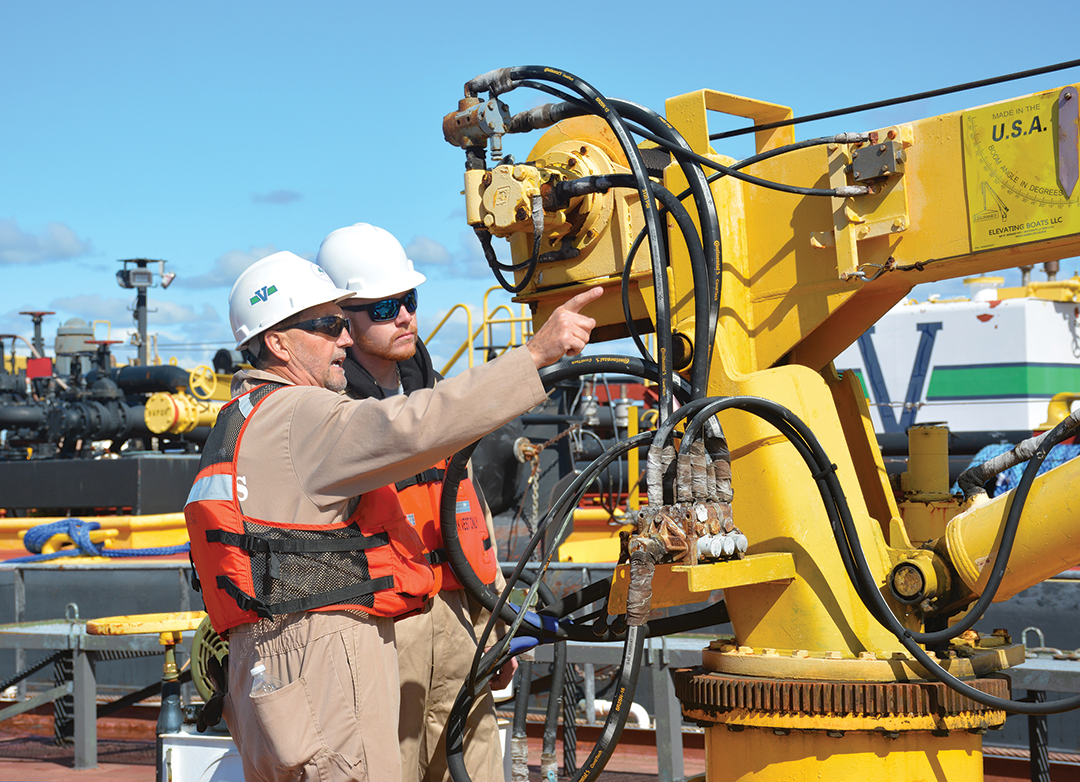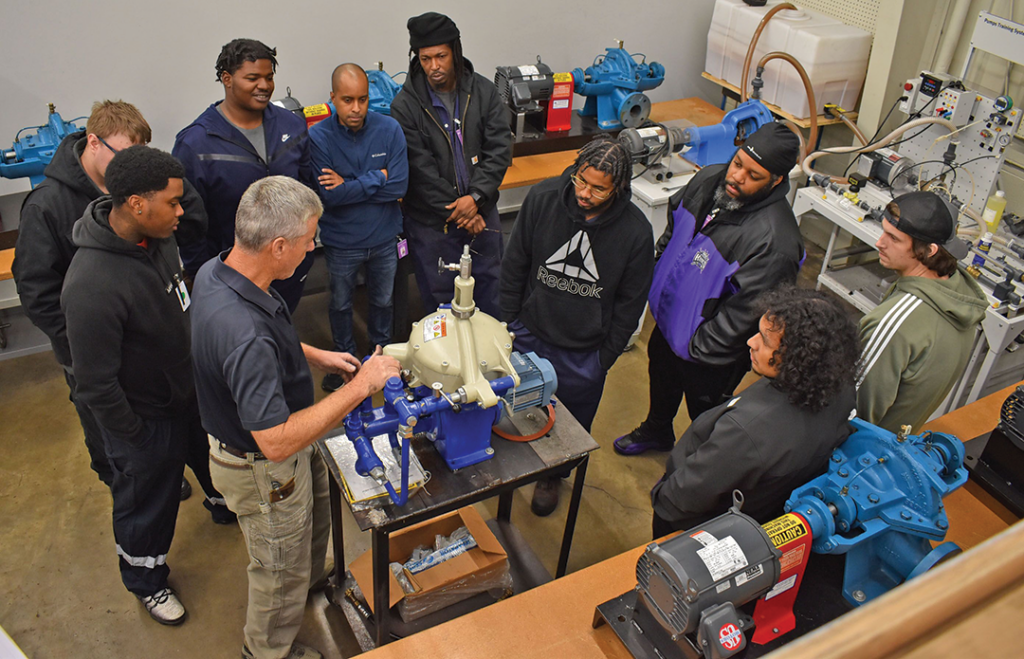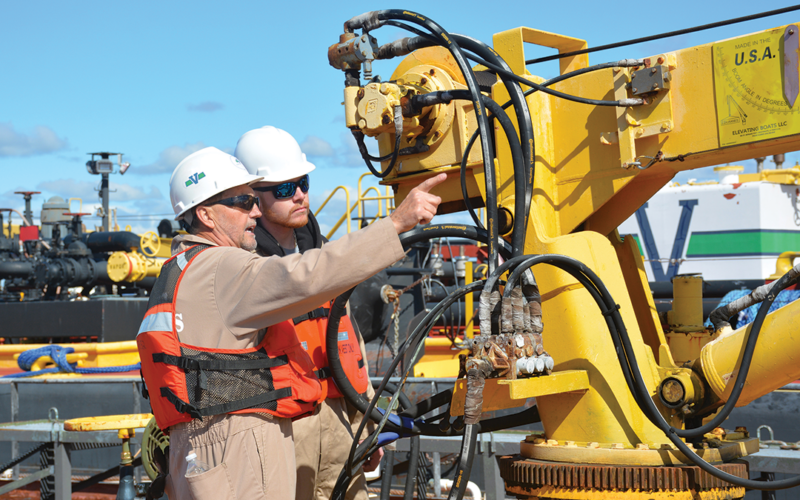
Despite the downsides of a maritime career, a professional life at sea can provide high pay and good benefits, interesting and meaningful work, and exciting experiences that stretch to the horizon and beyond.
A variety of mariner jobs beckon with learning the right way to do things in the wheelhouse, on deck and below, playing a critical role in developing the necessary skills to safely and efficiently work afloat.
On-the-job training is a tried-and-true way to develop that skillset with a number of companies offering programs to hone the next generation of mariners.
One such company is Baltimore, Md.-headquartered Vane Brothers. In business since 1898, the company operates a fleet of tugs, barges, and articulated tug-barge units all along the U.S. East, West, and Gulf Coasts
The company oversees an intensive training program to build its workforce for future growth which expanded even further in December 2023 with the addition of a tankerman training element that has received a nod of approval from the U.S. Coast Guard.
To meet the Coast Guard’s compliance standards, Vane Brothers’ Vice President of Operations, Captain Rick Iuliucci, and Marine Superintendent Rich Butrim worked closely with the Maritime Institute of Technology and Graduate Studies (MITAGS) to fine-tune course procedures.
Trainees receive up to one week of hands-on instruction at the company’s Baltimore headquarters and one week of tankerman/person-in-charge classroom learning at MITAGS. They perform tankerman duties dockside on a Vane Brothers’ barge and familiarize themselves with company software on computers inside the company’s headquarters.
“They’re able to take advantage of a great opportunity to get familiar with the equipment and build their confidence,” said Butrim.
“What they learn here will benefit our customers moving forward.”
The training is unique to the industry because it is customized specifically to Vane’s fleet and the company’s specific policies and procedures, according to Iuliucci.
“This program is an invaluable resource for Vane Brothers,” he said. “The ability to train tankermen to staff our fleet well into the future is critical. The good habits developed during these training sessions will serve the mariners well throughout their careers, and we in turn are getting the best-trained tankermen for the company and our customers.”

Trainees are required to complete three tours on one of the company’s barges. They follow their progress with Vane Brothers’ Show Them the Ropes training manual, which lays out the responsibilities that increase with each barge tour.
By their last tour, they are required to have performed a product transfer on their own while being observed by a qualified tankerman and the successful completion of a firefighting class at some point during their off time with reimbursement from the company for the cost of the class.
“Barge captains in the fleet that are working with the trainees give the thumbs up on the trainees’ knowledge received from the Vane tankerman class. This allows the barge captains to focus on fine-tuning the trainees’ skills of actually loading and discharging cargo,” said Butrim.
Austin Firth participated in the company’s first tankerman class and now works as an AB tankerman on a Vane Brothers’ asphalt barge. He and his fellow trainees “had a lot to learn,” he said, but they appreciated the company’s investment in them.
“Not one of us knew what the operation was like, so the biggest thing was getting to feel comfortable with what we expect to do on the job. It’s a big responsibility,” Firth said. “By feeding us, putting us on this equipment, and sending us to school, it shows the company’s commitment to our success.”
Approximately 40 trainees have completed the program as of late February.
For more experienced mariners wanting to advance their careers and take on wheelhouse responsibilities, Vane Brothers offers its ‘Mate-in-Training’ program.
A variety of factors go into who qualifies for the program, Iuliucci explained. “A lot depends on the candidate’s personality, work ethic, eagerness to learn, and desire to ‘want it. We also look for positive feedback from masters who make a recommendation based on having worked with the candidate.”
If all the boxes are checked, the trainee is assimilated into a real-world work environment to receive one-on-one tutelage from Vane masters with extensive knowledge of the tug and barge industry.
“We go at the trainee’s pace as he or she works with a dedicated instructor that understands not only what the trainee’s skill level is when handling a vessel but also how the trainee is as a person,” Iuliucci added. “Our goal is to develop a skilled professional trained for Vane’s specific needs, who understands how our tugs and barges handle, and who grasps how the company’s safety management system is integrated into our everyday lives.”

For Vane Brothers’ veteran barge crew members, mandatory tankerman/PIC refresher classes have been held at various Vane Brothers facilities. These single-day sessions focus on computer training, the company’s safety management system, and barge oil transfer procedures.
Trainees “have an opportunity to ask questions and receive answers in a small group setting to refresh their knowledge,” said Butrim. “It shows to our customers and the petroleum industry that we provide continuing training to our employees.”
There are also a number of organizations that offer training courses that, out of necessity, have evolved in scope as rapidly as the technologies that impact how mariners do their work.
The Seafarers International Union’s Paul Hall Center for Maritime Training and Education in Piney Point, Md., was founded in 1967 and has made some notable upgrades over time, including some high-tech improvements in recent years.
In 2021, the school opened a media center whose classrooms include touchscreen projectors and which allow interactive on-screen participation by students. Some of the coursework is approved for online completion, according to PHC Curriculum Coordinator Monica Szepesi.
The PHC also operates a full-mission, 360-degree, 4K-projection deck simulator equipped with dynamic positioning for offshore wind-related projects. The school also features two tugboat bridge simulators and a full-mission engine simulator with a touchscreen, she said.
Another upgrade took place at the PHC’s machine shop, which now boasts a top-of-the-line electrical lab, welding shop, refrigerated containers, lathes, pumps, piping systems, boilers, diesel engines and more.
“It’s no exaggeration to say that our courses are regularly changing to stay ahead of the latest technology and to continue meeting the needs of the vessel operators as well as those of individual mariners,” Szepesi said.
“Most of our classes involve hands-on training, and many of them truly are cutting-edge,” she said. “We work closely with the Coast Guard and with the ship operators to not only keep up with the times but to help lead the way with integrating the latest technology for mariners in all three departments – deck, engine, and steward.”
The center offers 120 courses, the vast majority of which are approved by the U.S. Coast Guard or the Military Sealift Command. The school is closely affiliated with the Seafarers International Union, and it provides instruction for both unlicensed and licensed mariners.
On a nearby satellite campus, the PHC operates a firefighting and safety school that includes a damage-control room that fills with water, a pool for water-survival training, and a ‘ship burn’ building that allows for live firefighting scenarios supervised by credentialed instructors.
The school also operates the 176-foot training ship Freedom Star, which sails once per month with a full crew. Classes are taught on board, and practical assessments also take place on the ship, a National Defense Reserve Fleet vessel acquired on loan from the U.S. Maritime Administration in April 2016.
 California State University Maritime Academy – Cal Maritime – is one of only seven degree-granting maritime academies in the United States and the only one located on the West Coast.
California State University Maritime Academy – Cal Maritime – is one of only seven degree-granting maritime academies in the United States and the only one located on the West Coast.
At the school, maritime subject material is merged with modern data processing tools such as ChatGPT’s application program interface to work on initiatives related to vessel tracking, fleet management, and sustainability.
The purpose of its new maritime informatics class is to prepare license-track students to meet the demand for maritime subject matter experts within the maritime informatics space, which is growing at a 20 percent compounded annual growth rate, according to press statement.
“Our students are preparing for the new reality of today’s high-tech, interconnected maritime industry,” said Steve Browne, dean of the Academy’s School of Maritime Transportation, Logistics, and Management. “This new course will equip these 21st century mariners with the 21st century skills that they will need to succeed in their careers.”
Cal Maritime is also home to an impressive 21,000 square foot, glass-walled simulation center that features two 360-degree projection systems and numerous smaller simulators that can interlink, an oil spill trajectory simulator, a liquid/gas cargo handling simulator, and a crisis management center. The facility creates a strikingly realistic environment for training, research, accident investigation, and crisis management.
In February, Cal Maritime representatives were on-hand at the Philly Shipyard to mark the cutting of steel for the school’s state-of-the-art National Security Multi-Mission Vessel (NSMV), scheduled for delivery in April 2026. The new training ship is the fifth, and last, of its class and “will undoubtedly aid in our mission of serving as a leading educational institution recognized for academic excellence and unique training opportunities in the Pacific Rim and beyond,” said Michael J. Dumont, Cal Maritime’s interim president.
Construction of the remaining NSMVs are well underway and are in various stages of production at Philly Shipyard since the first, the Empire State, was delivered to SUNY Maritime College in September 2023. Patriot State is undergoing testing and commissioning, while the State of Maine is preparing for launch, and the Lone Star State, had its keel laid down last December. •

